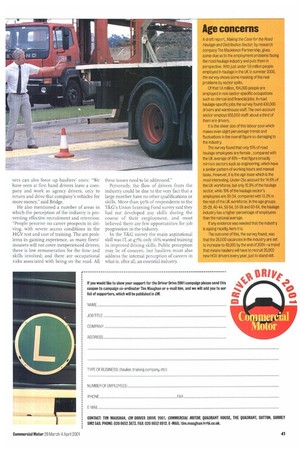wis
Page 42

Page 43

If you've noticed an error in this article please click here to report it so we can fix it.
From major fleet operators to owner-drivers and employed drivers, everyone knows there's a problem with recruitment, But is the driver shortage really bad enough to affect the industry as a whole? Ron Webb is in no doubt that it is, and as national secretary, road transport sector for the Transport & General Workers Union, he should know. Speaking in February at the road haulage industry conference, Driving Training Forward, he warned: "The cost of fuel and the requirements of the European Working Time Directive come second to the issue of driver training."
Conference delegates ranged from union shop stewards to large fleet operators; the event was designed to stop the rot at grass roots level. Webb's view that the industry is not attractive enough to young people was echoed by many. But when it comes to making road haulage more attractive—to retain experienced drivers as well as gaining recruits—he doesn't offer any quick fixes.
John Bridge, national chairman of the Road Haulage Association,suggested that the roots of the crisis go much wider than many in the industry would consider. "Public perception is a problem," he told delegates. "The population of the UK cannot live their lives as they do without the road haulage industry, but very few appreciate what the industry does.
"We have to move the industry forward in new ways," he added. "The fuel protests were not the answer to it, and if the Working Time Directive were applied to the self-employed we'd need another 40,000-50,000 drivers immediately. The situation is now so bad that some fleets are running only 75% of their vehicles because of driver shortages, and with the average age of the HGV driver being 53 the situation is set to become much worse."
The shortage is not uniform—Bridge cited three main problem areas. The long distance and international sector is, not unexpectedly, the worst case; not only because of the effects of foreign competition but because its working hours and time away from home make this the least sector for all drivers, from novices to veterans. Specialist haulage such as Special Types and hazgoods inevitably has a smaller pool of drivers to draw on, and it has working conditions similar to those of the international sector.
Most worrying of all is the shortage of drivers in the short and medium-distance sector. Although this would appear to have less severe conditions than the other two, rates of pay are a serious problem in this most competitive of areas.
From an operator's standpoint, the knockon effects of driver shortages can be financially crippling. Difficulties in daily operations can leave vehicles idle, with obvious financial implications, and in the long term a haulier who can't find drivers for his trucks is bound to lose contracts.
One obvious cause of a driver shortage is a flow of drivers taking jobs outside the industry, but a simple movement of available dri vers can also force up hauliers' costs: "We have seen at first hand drivers leave a company and work as agency drivers, only to return and drive that company's vehicles for more money," said Bridge.
He also mentioned a number of areas in which the perception of the industry is preventing effective recruitment and retention: "People perceive no career prospects in driving, with severe access conditions in the HGV test and cost of training. The are problems in gaining experience, as many fleets' insurers will not cover inexperienced drivers; there is low remuneration for the time and skills involved; and there are occupational risks associated with being on the road. All these issues need to be addressed."
Perversely, the flow of drivers from the industry could be due to the very fact that a large number have no other qualifications or skills. More than 50% of respondents to the T&G's Union Learning Fund survey said they had not developed any skills during the course of their employment, and most believed there are few opportunities for lob progression in the industry.
In the T&G survey the main aspirational skill was CT, at 47%; only r6% wanted training in improved driving skills. Public perception may be of concern, but hauliers must also address the internal perception of careers in what is, after all, an essential industry.








































































































